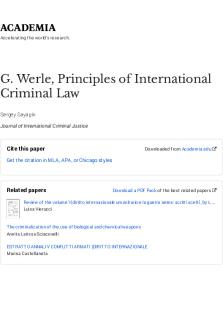Unit 1 – Principles of Criminal Law PDF

| Title | Unit 1 – Principles of Criminal Law |
|---|---|
| Course | Criminal Law |
| Institution | University of the West of England |
| Pages | 2 |
| File Size | 91.2 KB |
| File Type | |
| Total Views | 150 |
Summary
Concepts that underpin the aspects of the law....
Description
Unit 1 – Principles of Criminal Law Principles include ideas or concepts that underpin aspects of our criminal law. These are guidelines that we use to evaluate the law. They are also frequently the basis of academic debate or controversy. Fair Warning & Fair Labeling: Public interest in knowing what sort of conduct will bring you into conflict with the law. How does the general public assess the seriousness of an offence? Fair warning refers to the requirement that a criminal statute defines an offence with enough accuracy so it enables a reasonable person to know what counts as a criminal offence. The fairness of a label dictates the fairness of a warning. Fair labeling is that the offence the person has committed describes the crime they have committed. This gives moral stigma with the conviction for each offence. Ignorance of the law is not a defence. Autonomy & Welfare: How far should the law go to protect society? When should an act be criminalized? What if I do no want to be protected by the law? Fundamentals of Criminal Justice: the ‘Holy Trinity’ of Criminal Law: The presumption of innocence o The prosecution must prove its case. o A defendant does not have to prove their innocence. o Innocent until proven guilty. The right to silence o Used to be unqualified (since 17th century). o A right not to self incriminate. o Perceived as a way to evade conviction. o Abolished by Criminal Justice and Public Order Act 1994. o Now a qualified right to silence. The burden of proof o ‘Beyond all reasonable doubt’. o Woolmington v DPP [1935] AC 462. The link between each of these is Article 6 of the ECHR, which under Section 2 states that, a defendant is innocent until proven guilty. The three work together to form a safety net around the defendant. Elements of Crime: The principle of responsibility o The prosecution must prove ‘beyond all reasonable doubt’ that… o Defendant is responsible for the behaviour in question. o Defendant had the required state of mind in relation to that behaviour. o Actus reus = the external element of the crime. o Mens rea = the internal element of the crime.
Coincidence/Correspondence: The actus reus and mens rea must occur together. This can be summed up by the latin maxim: actus non facit reum nisi mens sit rea. Thus meaning an act is not sufficient; there must also be a guilty mind. Identification of Elements: Not always easy as terms of art....
Similar Free PDFs

Fundamentals of Criminal Law
- 24 Pages

Criminal Law assignment 1
- 5 Pages

Criminal Law 1 - notes
- 22 Pages

Criminal Law
- 77 Pages

Criminal Law Table of Cases
- 59 Pages

THE Concept OF Criminal LAW
- 11 Pages
Popular Institutions
- Tinajero National High School - Annex
- Politeknik Caltex Riau
- Yokohama City University
- SGT University
- University of Al-Qadisiyah
- Divine Word College of Vigan
- Techniek College Rotterdam
- Universidade de Santiago
- Universiti Teknologi MARA Cawangan Johor Kampus Pasir Gudang
- Poltekkes Kemenkes Yogyakarta
- Baguio City National High School
- Colegio san marcos
- preparatoria uno
- Centro de Bachillerato Tecnológico Industrial y de Servicios No. 107
- Dalian Maritime University
- Quang Trung Secondary School
- Colegio Tecnológico en Informática
- Corporación Regional de Educación Superior
- Grupo CEDVA
- Dar Al Uloom University
- Centro de Estudios Preuniversitarios de la Universidad Nacional de Ingeniería
- 上智大学
- Aakash International School, Nuna Majara
- San Felipe Neri Catholic School
- Kang Chiao International School - New Taipei City
- Misamis Occidental National High School
- Institución Educativa Escuela Normal Juan Ladrilleros
- Kolehiyo ng Pantukan
- Batanes State College
- Instituto Continental
- Sekolah Menengah Kejuruan Kesehatan Kaltara (Tarakan)
- Colegio de La Inmaculada Concepcion - Cebu









